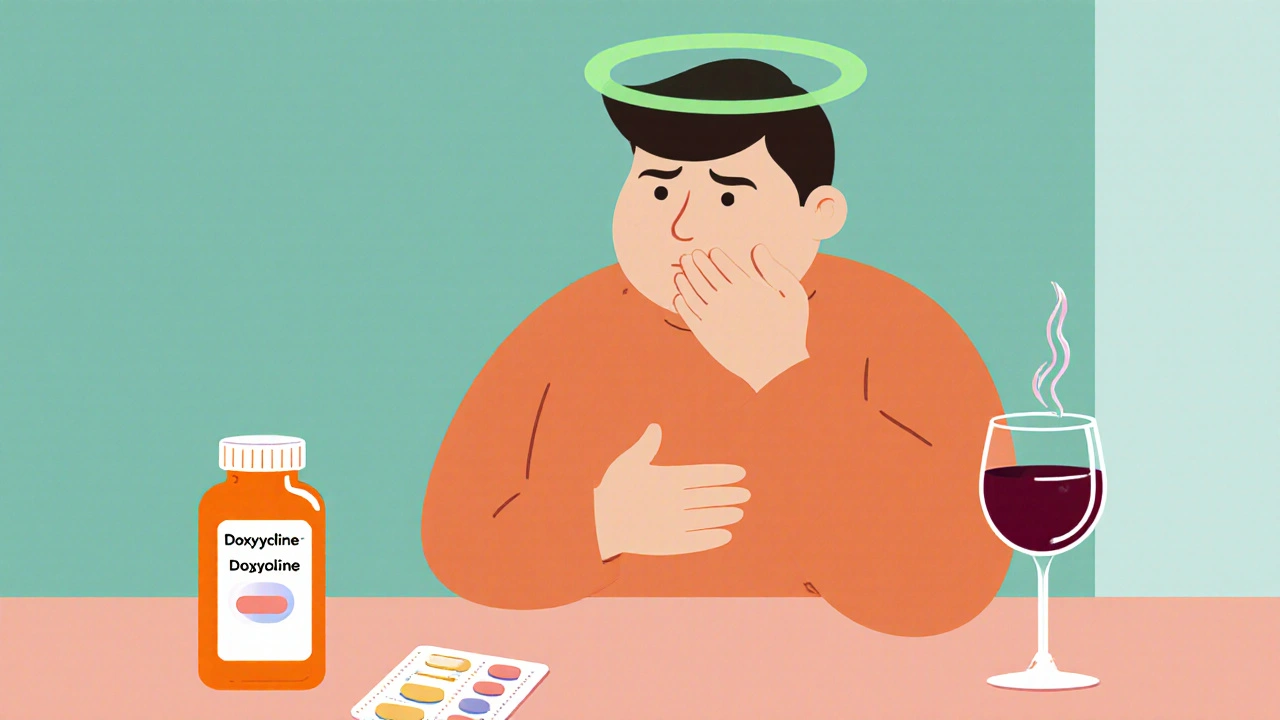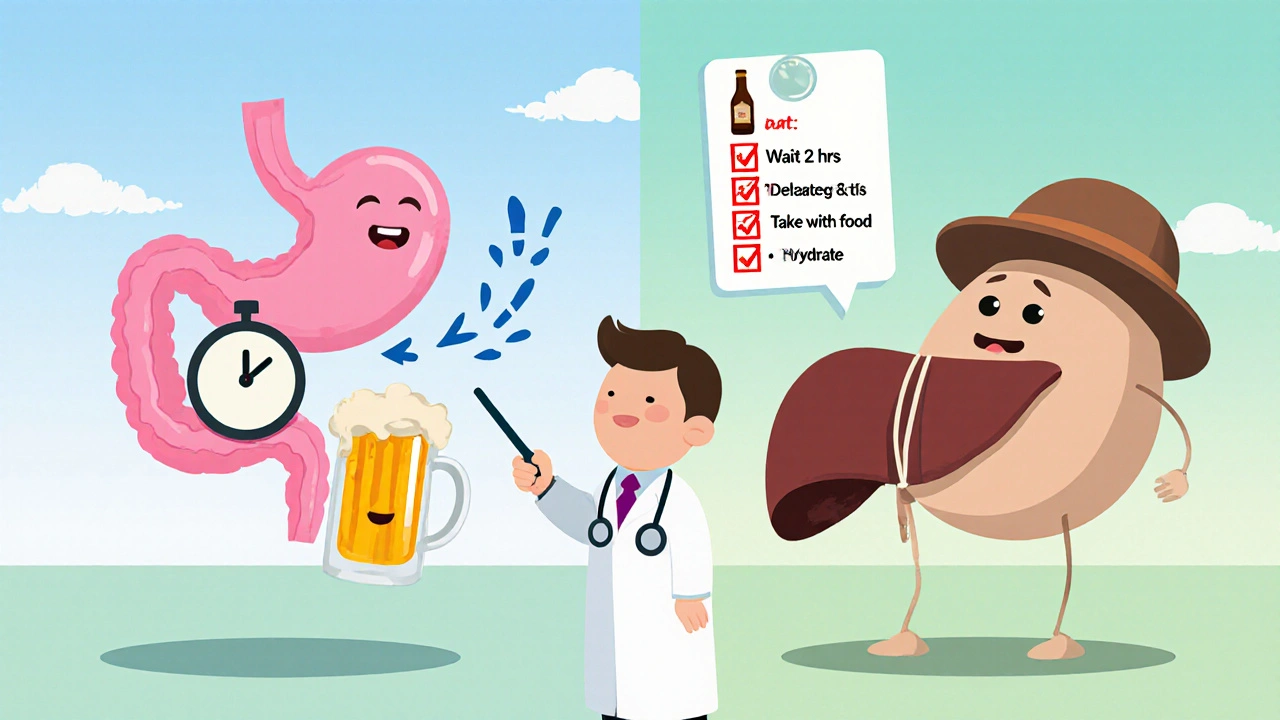Doxycycline and Alcohol: Risks, Side Effects, and Safe Use Guide

Doxycycline Alcohol Timing Calculator
Calculate Your Safe Window
Based on medical guidelines, determine the earliest safe time to consume alcohol after taking doxycycline.
Your Safe Alcohol Window
Quick Takeaways
- Mixing doxycycline and alcohol can increase nausea, stomach upset, and dizziness.
- Doxycycline’s absorption drops a bit if you drink within an hour of taking it.
- Serious liver‑related reactions are rare but possible, especially with heavy drinking.
- If you miss a dose after drinking, take it as soon as you remember - don’t double up.
- Other antibiotics (e.g., metronidazole) have stricter alcohol warnings; doxycycline is on the milder end.
When it comes to Doxycycline is a broad‑spectrum tetracycline antibiotic used for everything from acne to Lyme disease. People often wonder whether a glass of wine or a weekend binge will ruin the treatment. The short answer: occasional, moderate drinking isn’t a deal‑breaker, but the combo can aggravate common side effects and, in rare cases, strain your liver.
What Is Doxycycline?
Doxycycline belongs to the Tetracycline antibiotics class. It works by stopping bacteria from making proteins they need to grow. Because it’s absorbed well from the gut, it’s taken orally in 100 mg or 200 mg tablets, usually once or twice daily. Typical courses run from 7 to 14 days for infections, but acne treatment can stretch to several months.
How Alcohol Affects Doxycycline
Alcohol itself isn’t chemically “reactive” with doxycycline, but it can interfere in three main ways:
- Absorption hiccup: Drinking right before or after your dose can delay gastric emptying, shaving off 10‑20% of the drug’s absorption.
- Side‑effect overlap: Both alcohol and doxycycline can cause nausea, stomach upset, and dizziness. Combine them, and you’ll feel the sum of both.
- Liver load: Doxycycline is metabolized a bit in the liver. Heavy alcohol use raises liver enzymes, which can theoretically increase the risk of hepatotoxicity, though real‑world cases are scarce.
In other words, the interaction isn’t a life‑threatening firestorm, but it can make you feel worse and possibly reduce the drug’s effectiveness.
Common Side Effects When Mixed
The most frequently reported issues are:
- Stomach cramping or heartburn
- Headache or light‑headedness
- Photosensitivity - you’ll burn faster in the sun, and alcohol can heighten that sensation.
These are the same problems you might get from doxycycline alone; alcohol simply amplifies them. If you experience persistent vomiting, dark urine, or yellowing of the skin, stop drinking and contact your clinician right away - those could hint at liver trouble.

Who Should Avoid Mixing?
Certain groups need to be extra careful:
- Pregnant or breastfeeding women - doxycycline can affect fetal bone growth; add alcohol and the risk compounds.
- People with a history of liver disease - even moderate drinking can tip the balance.
- Those on other drug interactions that already burden the liver (e.g., anticonvulsants, some antiretrovirals).
If any of these apply, the safest route is to skip alcohol until the antibiotic course ends.
Practical Guidance - Should You Skip a Drink?
The rule of thumb: keep a two‑hour window between your dose and any alcoholic beverage. This gives your stomach time to empty, preserving most of the drug’s bioavailability. Here’s a quick checklist:
- Take doxycycline with a full glass of water, preferably with food.
- If you plan to drink, wait at least one hour after the pill.
- Enjoy a moderate amount - think one glass of wine or a standard beer.
- Stay hydrated; water helps both the drug and alcohol clear faster.
- Watch for side effects. If they worsen, pull back on alcohol or pause it altogether.
How Doxycycline Stacks Up Against Other Antibiotics
| Antibiotic | Alcohol Interaction Severity | Typical Use Cases | Notes |
|---|---|---|---|
| Doxycycline | Low‑to‑moderate (nausea, stomach upset) | Acne, Lyme disease, respiratory infections | Best taken with food; avoid heavy drinking. |
| Amoxicillin | Low (mostly tolerable) | Ear infections, strep throat | Few restrictions, but still watch for stomach irritation. |
| Azithromycin | Low (minor GI effects) | Chlamydia, bronchitis | Single‑dose regimens reduce overlap risk. |
| Metronidazole | High (severe nausea, flushing, vomiting) | Clostridium difficile, bacterial vaginosis | Strict no‑alcohol rule for 48 hours after last dose. |
From the table you can see doxycycline lands in the “low‑to‑moderate” zone, far less risky than metronidazole’s notorious disulfiram‑like reaction. That’s why doctors often prescribe doxycycline when patients still want occasional drinks.

What To Do If You Accidentally Drink
First, don’t panic. Take these steps:
- Hydrate with water or an electrolyte drink.
- Eat something light - crackers, toast, or a banana can settle the stomach.
- Monitor symptoms. Mild nausea usually fades in a few hours.
- If you feel dizzy or notice a rapid heartbeat, sit down, breathe deeply, and consider a short walk.
- Contact your healthcare provider if vomiting persists, you develop a fever, or notice dark urine.
Skipping the next dose isn’t necessary unless you’re feeling ill. Just resume the regular schedule once you’re back to baseline.
Bottom Line
Doxycycline is forgiving when it comes to a glass of wine or a beer, but the combination can turn up the volume on common side effects and shave a bit off absorption. Keep a safe window, stay hydrated, and know when to call the doctor. When in doubt, plan a short break from alcohol until the prescription ends.
Frequently Asked Questions
Can I take doxycycline on an empty stomach?
It’s best to take doxycycline with food or a full glass of water. An empty stomach can increase stomach irritation, especially if you also drink alcohol.
How long should I wait after drinking before taking doxycycline?
Aim for at least a one‑hour gap. If you can, wait two hours; that maximizes drug absorption and cuts down on nausea.
Is the doxycycline‑alcohol interaction dangerous?
For most healthy adults, it isn’t life‑threatening. The main concern is amplified GI upset and a small dip in effectiveness. People with liver disease should be more cautious.
Can I take other antibiotics with alcohol safely?
Many antibiotics, like amoxicillin or azithromycin, have low interaction risk. However, metronidazole and tinidazole have severe reactions and require a strict no‑alcohol rule.
What should I do if I experience severe liver pain while on doxycycline and drinking?
Stop drinking immediately, stop the antibiotic, and seek medical help. Severe pain could signal hepatotoxicity, which needs prompt evaluation.

15 Comments
Wow!!! You read that article and feel like the universe is conspiring against your liver...??! The idea that a single glass of wine could sabotage an antibiotic regimen is downright terrifying!!! It's like being trapped in a horror movie where the villain is a pill bottle and the sidekick is a cheap beer!!!
I agree, a moderate amount is fine if you keep a gap.
From a pharmacokinetic perspective, doxycycline exhibits a bioavailability of approximately 95% under fasting conditions; concomitant ethanol ingestion may delay gastric emptying, thereby reducing Cmax by 10‑20% without altering the elimination half‑life, which remains around 18‑22 hours.
Honestly, darling, the notion that a simple merlot could turn your doxy regimen into a catastrophic opera is pure melodrama-think of it as a tiny tempest in a teacup, not a full‑blown hurricane, lol.
Consider the balance between pleasure and health as a microcosm of life's broader dialectic; allowing a modest drink respects both the body's need for recovery and the soul's desire for enjoyment, provided the timing respects pharmacological constraints.
Hey folks! 🍻 If you’re on doxy and planning a night out, just remember to hydrate 💧, eat something light 🍞, and keep the drinks moderate. You’ll be fine! 👍
Yeah, just don’t go overboard and you’ll be good.
Enough with the lukewarm advice!!! If you think a single pint won’t matter, you’re living in denial!!! The liver is a warrior, not a punching bag-treat it with respect or suffer the consequences!!!
It is advisable to maintain a minimum interval of two hours between the ingestion of doxycycline and the consumption of alcoholic beverages, thereby ensuring optimal absorption and mitigating gastrointestinal discomfort.
Great point! Keeping that window open not only protects your treatment but also lets you still enjoy a toast with friends. Remember, a little planning goes a long way toward a speedy recovery.
Doxycycline’s interaction with alcohol is low, but vigilance is prudent.
Oh, thank heavens you’ve reminded us that a single beverage could render antibiotics useless-who would have thought?
Take care and listen to your body it will guide you
When navigating the complex terrain of antibiotic therapy intersected with occasional social drinking, it is essential to adopt a holistic perspective that appreciates both the biochemical mechanisms at play and the psychosocial dimensions of patient behavior. First, the pharmacodynamics of doxycycline reveal that its antimicrobial efficacy hinges upon sustained plasma concentrations, which can be subtly perturbed by the delayed gastric emptying associated with ethanol intake. Second, the gastrointestinal side effects such as nausea, gastritis, and photosensitivity are amplified when the mucosal lining is concurrently irritated by alcohol, creating a synergistic discomfort that may discourage adherence. Third, while the hepatic metabolism of doxycycline is modest, chronic alcohol consumption can up‑regulate cytochrome P450 enzymes, potentially altering drug clearance in susceptible individuals. Fourth, the psychosocial incentive to partake in a celebratory drink must be weighed against the risk of undermining therapeutic outcomes, especially in infections where bacterial load is high. Fifth, clinical guidelines consistently recommend a buffer period of at least one to two hours between dosing and alcohol consumption to preserve bioavailability. Sixth, patient education should emphasize hydration and the consumption of a light snack to mitigate stomach upset. Seventh, monitoring for signs of hepatotoxicity-such as jaundice, dark urine, or right‑upper‑quadrant pain-is prudent in any scenario involving combined use. Eighth, the rarity of severe liver injury in the context of doxycycline and moderate alcohol use should not breed complacency; vigilance remains key. Ninth, for individuals with pre‑existing liver disease, even modest alcohol intake can tip the balance toward decompensation. Tenth, in pregnant or lactating patients, the additive teratogenic potential warrants abstinence. Eleventh, the broader public health perspective underscores the importance of adherence to antibiotic regimens to curb resistance. Twelfth, alternative social activities that do not involve alcohol can provide comparable enjoyment without compromising treatment. Thirteenth, should an inadvertent lapse occur, promptly re‑hydrating and seeking medical advice if symptoms persist is advisable. Fourteenth, the overarching message is that responsible moderation, informed timing, and attentive self‑care collectively preserve the therapeutic integrity of doxycycline while allowing for a measured social life. Fifteenth, by integrating these strategies, patients can successfully navigate the intersection of medicine and merriment without sacrificing health.
Do you think the two‑hour rule works for everyone?